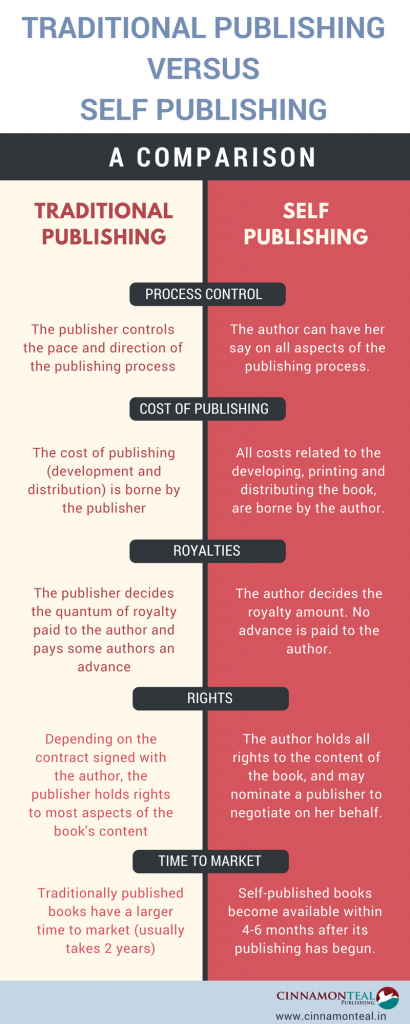The main purpose of this article is to spell out the differences between traditional publishing and self-publishing, and enumerate its pros and cons, so that an author seeking to publish her book can decide which of the two options to choose. While many may interpret these differences in other ways, this is how we at CinnamonTeal Design and Publishing see them.
The term “traditional publishing” or “mainstream publishing” refers to publishing as it is usually understood – where the publisher bets on the book and spends on it. In this mode of publishing, the common practice is for a publisher to either commission a book i.e. to ask an author to write on a particular topic, or to solicit manuscripts for publication. In the latter case, not all manuscripts are published, rather each solicited manuscript is passed through a round of editorial review. Once the publisher has decided to publish a book, all expenditures related to the book – its editing, design, printing, marketing and distribution – are borne by the publisher. In many instances, the publication process starts with an agreement in which the author hands over the rights to the book to the publisher, and in turn agrees to a ‘royalty fee’, a fixed percentage of sales paid to the author by the publisher. In some cases, an advance is paid against future royalty earnings.
 Since the publisher is literally putting its money on the book, the publisher is choosy about the book it will publish. (Usually a publisher will publish just one kind of book, a genre, like crime thrillers, for instance. Or it may publish many genres under different labels, or imprints. For instance, Penguin India publishes business books under its Portfolio imprint and other contemporary non-fiction under its Allen Lane imprint.) A publisher may therefore choose to reject a book that is submitted to it by its author because the book does not fit among the books it has chosen to publish, or because the publisher does not see a market large enough for the book to be able to recoup its investments in that book. Please remember that a traditional publisher may reject your book even if it is a good one [https://scroll.in/article/832753/eight-reasons-that-even-a-good-book-is-rejected-by-publishers].
Since the publisher is literally putting its money on the book, the publisher is choosy about the book it will publish. (Usually a publisher will publish just one kind of book, a genre, like crime thrillers, for instance. Or it may publish many genres under different labels, or imprints. For instance, Penguin India publishes business books under its Portfolio imprint and other contemporary non-fiction under its Allen Lane imprint.) A publisher may therefore choose to reject a book that is submitted to it by its author because the book does not fit among the books it has chosen to publish, or because the publisher does not see a market large enough for the book to be able to recoup its investments in that book. Please remember that a traditional publisher may reject your book even if it is a good one [https://scroll.in/article/832753/eight-reasons-that-even-a-good-book-is-rejected-by-publishers].
Further, the publisher will take all necessary steps to ensure that the book appeals to its audience. The publisher brings its wisdom and experience to bear upon this process of developing the book for its market. That might mean making certain changes to the text, developing a cover that it finds suitable, setting an appropriate price for the book, and formulating a marketing plan appropriate for the book. The publisher can choose to do all of this without the involvement of the author. Based on its estimation of the market, the publisher will choose to print a certain number of copies of the book, and reprint or discontinue the book depending upon the response it gets. Depending upon the nature of the contract signed between the author and the publisher, the publisher has the freedom to negotiate and sign on agreements for translations of the book into other languages, for conversion into other electronic formats, and even for TV or movie rights.
So how is it different from self-publishing?
The self-publishing route differs from traditional publishing in the following aspects:
Cost: All costs related to the developing, printing and distributing the book, are borne by the author. That means the author remains fully invested in the process. Consequently, the author also has a say in all matters related to the book. Some options, such as crowdsourcing, that will make it easier for authors to fund their books are now available.
Control: This follows from the previous point. Having paid for the book, the author gets to decide (rather, should be given a chance to decide) on every aspect of the book, such as the book dimensions, the type of binding, the nature of the cover, the number of copies printed and the avenues of distribution.
Profits: All profits go to the author. Any deductions, if held back by the service provider, should be communicated to the author, preferably before the service is undertaken. The author must receive an explanation of the costs and reimbursements. Typically, the author gets to choose the quantum of royatly payable after each copy is sold, and, based on that, the price of the book. The author agreement, that every self-published author must read before signing, must explain how profits, and royalty, will be disbursed to the author. No advance on royalties is paid to the author.
Rights: The rights to the contents of the book remain vested with the author. Thus, the author decides on the rights for translations, serialization rights, rights to convert to other formats, as also TV and movie rights. An author agreement is therefore very important for authors who self publish, more importantly one that explains where the rights to various aspects of the book will be vested.
Time to Market: A self-published book almost always makes it to the market earlier than a book that is traditionally published. A six-month period is considered as the average time a book takes to become available when the author chooses the self-publishing route.
Having said that, self-publishing does not appeal to many. That is because self-publishing is hard work. It means a total commitment to the self-publishing process, understanding every aspect of the process, taking time to learn how publishing works, and, very importantly, taking it upon yourself to ensure that the book is adequately marketed and distributed. Self-publishing cannot be for authors who will outsource the task of monitoring the process to a third party.
On the other hand, a majority of authors do prefer the tradional publishing way. And for good reason:
There is prestige and validation: Being a published author implies having your book approved by a team of editors. That in itself is a badge of approval that many authors relish. Such validation does not come easily to self-published authors. In fact, in the case of many genres, such as academic books, self-published books are frowned upon. That stigma, though, is slowly disappearing.
Your book is worked upon by a large team of book editors, designers and marketeers: Very often the team assembled to work on your book has many years of experience between them. Given that the publisher has invested a lot of money in the book, it naturally follows that this team is charged with publishing a very good book. When you self-publish, on the other hand, you choose the team you will work with.
Distribution becomes easier: Book distributors and retailers believe that a book from a traditional publisher will be worth selling since it is assumed that the content is properly vetted and edited and a lot of effort has been put into developing a good book. No retailer would shun a good product and the publisher’s imprint assures the retailer of just that. Like many self-published authors will avow, getting physical stores to keep their books on their shelves is next to impossible.
There are no costs to the author, a lucky one might actually receive a royalty: In the traditional publishing model, the publisher invests the money necessary to develop, market and distribute the book. In case of established authors, the publisher might actually offer the author an advance against future royalties.
A traditionally published book is more likely to be accepted for awards and acclaim: Many literary awards are not open to self-published authors, and remain available for traditionally published books alone.
Self-publishing can be a way to get published the traditional way. Many authors have found commercial and critical success with their self-published books as a result of which publishers following the traditional model of publishing have noticed them and offered them a proposal for their next book. Ultimately it is the decision of the author, to choose which route to take. There cannot be any substitute for hard work and writing a good book. That done, both models are guaranteed to get the market to sit up and notice your book.
